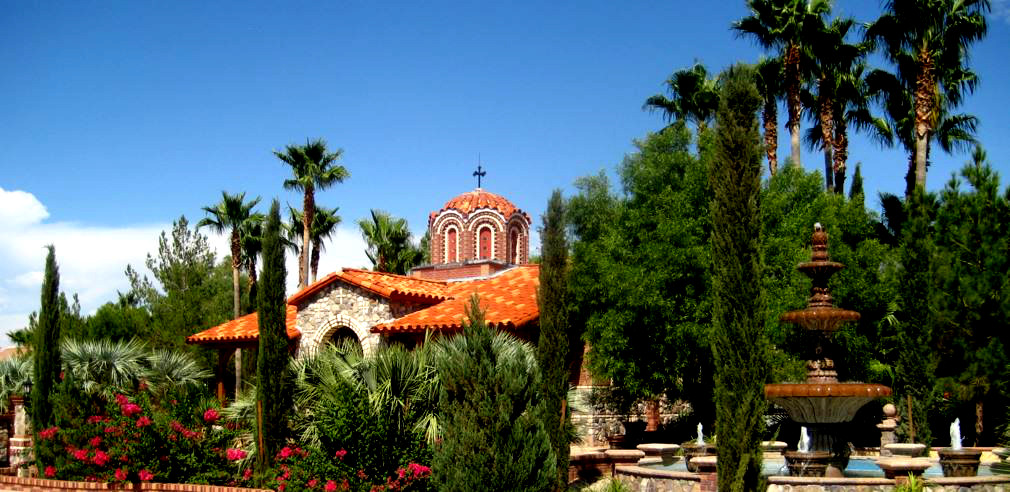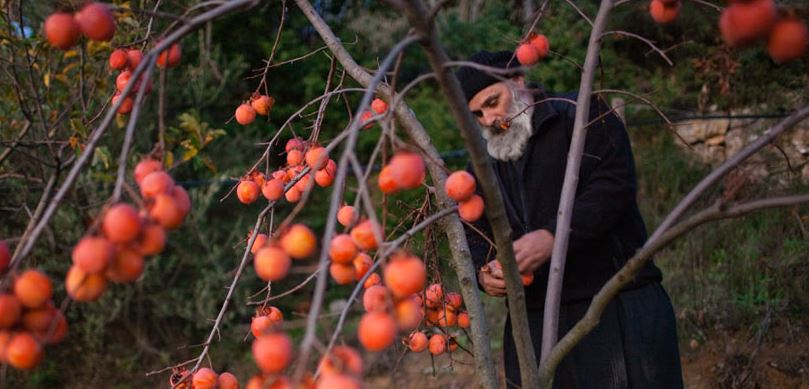
A Church and vegetation at St. Anthony Monastery, Florence, AZ
by Fr. John A. Peck
The answer is, what do you need?
Every parish has its own needs. Think about it. You need food – fruits and vegetables to survive, but also for our liturgical and sacramental life – wheat for bread, wine, oil for lamps and anointing, wax for candles, eggs for iconography, incense for worship, and, of course, water – and lots of it.
Allow me to describe, briefly, my first Permaculture Design Project. In my first project, which I designed for my certification, the task was to create a project design for a church property. The property included the church temple, fellowship hall, offices/apartment for the priest, and an additional building designated for a school, but currently used for storage and living quarters for additional staff – all on 3/4 of an acre.
As this church was in an hot arid climate, a primary concern would be rainwater collection for use in the project. Easy enough.
With plenty of on location living, there was included an enclosed area for a large kitchen garden to feed the priest’s family and support staff. This area would also house a decent sized chicken coop and run.
Because of the exceptionally hot summers, bamboo would be planted on the southwest side of the priest’s apartment for shade.
Near the kitchen garden, Herbs and Flowers for Dormition, as well as to attract beneficial pollinators.
Did you know you can grow frankincense trees? These were allotted to the east side of the property, near some cactii.
We even included room for an apiary, since we need bees for wax and honey for blessing on August 1st, as well as candles for the Meeting of the Lord on Feb. 2nd.
Eggs would be provided by the chickens for traditional egg tempera iconography and for Paschal eggs.
A multitude of polyculture fruits and trees would turn the three quarters of an acre almost into a park, but well shaded, directing rainfall into natural holding areas (swales) which would feed the trees. From citrus to melons, from apples to many exotic tropicals, the rest of the property would be sown as a fruit and nut forest, enriching the soil with mulch, bringing a large variety of birds and pollinators (which would cut down on desert vermin like snakes, scorpions and poisonous spiders), and providing some charity food, and a market crop.
Grapes for Transfiguration of several varieties would use the other trees to climb. Eventually, the church may even be able to make its own communion wine. Many monasteries do this on 1/4 of an acre.
A small pond would also serve, in the shallow end, as a baptismal font, fed by run off and captured rainwater, and cycled through the system using a solar powered pump. Also a perfect location for the Blessing of Waters at Theophany, right on the Church grounds.
Eventually, a small area would be set aside for a community garden so that the neighborhood could join in themselves and learn to grow their own food easily and with little effort.
Even in the desert.
You see, Permaculture is really… Orthodox.

The practice of prayer is easier in a garden
What to do next?
No one can do everything, but everyone can do something, so the saying goes. Every parish can do something significant. Besides, it really doesn’t matter what others say or do, only what we say and do.
If you have been reading these articles, and watching the videos included in them, then here’s what to do next.